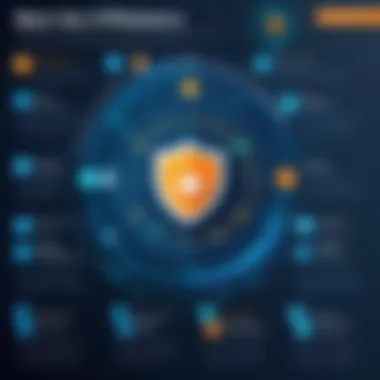Identifying and Addressing VPN Security Weaknesses


Intro
In today’s fast-paced digital age, the very notion of privacy has taken on a new meaning. Increasingly, individuals are opting for VPNs, or Virtual Private Networks, to create a watertight barrier between their personal browsing activities and the prying eyes found across the internet. But while VPNs hold the promise of anonymity and security, the reality can be rather murky. Users often operate under the assumption that by merely connecting to a VPN, they are shielding themselves from threats. However, underlying vulnerabilities can expose them to significant risks.
Overview of Cyber Security Threats
As the digital landscape expands, so does the complexity of the threats that loom over users. Cybersecurity threats are like shadows, lurking and evolving continuously. They come in various forms, each with their unique characteristics.
Types of Cyber Threats
- Malware: This is a catch-all term for malicious software designed to disrupt, damage, or gain unauthorized access to computer systems. Examples include viruses, spyware, and Trojans.
- Phishing: This technique involves tricking individuals into revealing personal information through deceptive emails or websites. It’s almost like baiting a hook.
- Ransomware: Such attacks encrypt data on a victim's computer and demand a ransom for its release.
The landscape of cyber threats doesn't stand still; it shifts rapidly, making it tricky for people to protect themselves effectively.
Statistics on Cyber Attacks
To underscore the seriousness of these threats, consider this: according to recent reports, cyberattacks have surged by over 50% in the last year alone. The aftermath of these breaches signifies not just financial loss but also reputational damage for individuals and companies alike.
Real-life Examples of Security Breaches
One only needs to recall the notorious WannaCry ransomware attack that crippled thousands of computers worldwide in 2017. It disrupted entire healthcare systems, illustrating how easily vulnerabilities can be manipulated by cybercriminals.
Best Practices for Online Security
Being aware of the threats is just the first step. It’s essential to adopt best practices for online security to fortify personal defenses.
- Strong Password Creation and Management: A coherent strategy here is key. Use long, complex passwords combined with phrases that are easy to remember but difficult for others to guess.
- Regular Software Updates and Patches: Keeping software up-to-date is tantamount to bolting the doors and windows of your online house. Ensure that your VPN, operating system, and all applications are regularly updated.
- Two-Factor Authentication Implementation: Adding this additional layer of security can mean the difference between thwarting an attack or falling prey to one.
Tips for Ensuring Online Privacy
Understanding how to secure your online presence is pivotal in today’s interconnected world. Here are some tips:
- Importance of Using VPNs for Secure Browsing: A well-configured VPN not only enhances security but also obfuscates your digital footprint from hackers and intrusive advertisers alike.
- Privacy Settings on Social Media Platforms: Take a moment to review your privacy settings. These platforms often default to share more than you might think.
- Protecting Personal Data When Making Online Transactions: Always use trusted websites and verify the presence of HTTPS in the URL before entering sensitive information.
Educational Resources and Guides
Knowledge is power, especially in the domain of online security. Several resources can help strengthen personal defenses:
- Articles on setting up encryption tools can guide even the most novice users.
- Step-by-step guides on spotting phishing emails can be invaluable, as they teach individuals the typical signs.
- Cheat sheets that outline quick security practices are easy-reference resources that many find handy in a busy world.
In summary, being vigilant and informed about the landscape of cyber threats is crucial for anyone seeking to safeguard their online presence. Taking the initiative to embrace best practices could mean the difference between privacy and potential chaos.
Each of these steps is invaluable in ensuring that VPNs live up to their reputation in the security landscape. As cybersecurity continues to evolve, so too must our strategies for protection.
Understanding VPN Technology
In the ever-evolving landscape of online security, grasping the fundamentals of VPN technology is crucial. A Virtual Private Network, commonly referred to as a VPN, serves as a digital shield, enabling users to navigate the internet while obscuring their identity and location. Understanding this technology not only aids in grasping the vulnerabilities discussed later in the article, but also empowers users with the knowledge to take proactive measures in securing their online presence.
VPNs create a secure tunnel for data, effectively protecting users from eavesdropping and ensuring that the data transmitted is encrypted. With growing digital risks like hacking and unauthorized surveillance, the significance of robust VPN technology cannot be overstated. Moreover, the ability to maintain privacy while accessing geographically restricted content adds an alluring layer to the appeal of VPN services.
What is a VPN?
A VPN is a technology that forms an encrypted link between your device and a VPN server, allowing secure online browsing and data transmission. By using a VPN, your internet traffic is routed through a remote server before reaching the final destination. This means that your IP address—the unique identifier for your connection—becomes masked, thereby keeping your online activities under wraps. In simpler terms, it’s like wearing an invisibility cloak while surfing the web, shielding you from prying eyes.
How VPNs Work
VPNs function through a combination of protocols and technologies. The moment a user connects to the VPN service, their device initiates a handshake with the VPN server. This handshake negotiates an encrypted connection, using protocols such as OpenVPN, L2TP, or IPsec. The data is then encapsulated, meaning it is wrapped up securely, ensuring that anyone attempting to intercept it would only see garbled nonsense.
In practical terms, when you search for something online while connected to a VPN, the request passes through the VPN server. The server fetches the information and sends it back to you, effectively masking your actual location and ISP. The benefits of this are clear: not only are you shielded from local restrictions, but you are also protected from your internet provider’s prying eyes.


Common Uses of VPNs
VPN technology finds its application in various scenarios, each tailored to meet specific privacy needs:
- Enhanced Privacy: Individuals seeking to keep their browsing habits confidential use VPNs to mask their identity.
- Bypassing Geographical Restrictions: Many users employ VPNs to gain access to content that is blocked or restricted in their country or region.
- Secure Remote Access: Businesses use VPNs to allow employees to connect to the company's network securely, no matter where they are.
- Protection on Public Wi-Fi: With the increase in public Wi-Fi hotspots, using a VPN provides a safeguard against potential threats.
Overall, understanding what a VPN is, how it works, and its typical uses sets the stage for delving deeper into the vulnerabilities that can arise with this technology. The internet is a wild west of both opportunities and threats. Grasping the mechanics of VPN technology is the first step toward ensuring your safety when you venture into the digital realm.
Identifying VPN Vulnerabilities
Understanding VPN vulnerabilities is crucial for anyone navigating the vast digital landscape today. VPNs act as a protective shield for your online presence, but this shield may have some cracks. Identifying these cracks is essential not just for tech aficionados but for the average user who values their online privacy.
By pinpointing vulnerabilities, users can better understand the risks they face. This goes beyond mere awareness; it entails taking proactive measures to safeguard personal data and maintain anonymity. Recognizing where these vulnerabilities lie is the first step toward fortifying that protection.
Types of Vulnerabilities
- Configuration Issues
When a VPN is improperly set up, it may expose users' data rather than safeguard it. This can be due to default settings that have not been changed or misconfigurations in the network settings. Configuration issues often lead to data leaks, potentially allowing third parties to access sensitive information.
A key characteristic of configuration issues is that they are often an oversight on the user's part. Many consider VPN setup as a one-time task, but it's vital to regularly verify that configurations align with best practices. One unique feature of these issues is that they can vary widely across different providers. For instance, a VPN with robust encryption may still be vulnerable if its leaks are not addressed. The advantage of being aware of configuration issues is that they can often be fixed with simple adjustments, which can thwart a whole range of potential privacy breaches. - Protocol Weaknesses
Protocols dictate how your data travels online. Some VPN providers use outdated or insecure protocols, which can leave data more vulnerable than it ought to be. This is a significant area of concern for anyone utilizing a VPN. A key point here is that not all protocols provide the same level of security; while some are fast, they might sacrifice security.
For example, PPTP is known for its speed but has several known vulnerabilities. On the other hand, OpenVPN, though slower, offers superior security features. This highlights a unique aspect of protocol weaknesses: the trade-off between speed and security. In summary, being aware of these weaknesses allows users to make more informed decisions when selecting their VPN service. - DNS Leaks
Imagine you’re browsing the web behind a VPN, only to find that your DNS requests are still visible to your ISP or other entities. That’s DNS leaking—a significant vulnerability that can unravel your privacy safeguards. A fundamental characteristic of DNS leaks is that they typically occur when a VPN fails to funnel DNS requests through its own secured servers. This exposes your browsing activity.
The unique feature of DNS leaks is that even if you are connected to a VPN, they can happen without users being aware. Users might think their data is protected while it’s willingly giving away information to their ISP. Awareness of DNS leaks can lead to choosing VPNs that provide built-in leak protection, essentially offering an upper hand in securing your internet usage. - Data Encryption Flaws
Encryption is the backbone of VPN security; this is where vulnerabilities can have dire consequences. Flaws in data encryption can lead to potential data breaches and unauthorized access. It is essential to recognize that not all encryption methods are created equal. A notable characteristic of data encryption flaws is their ability to evolve as technology advances.
As computational power increases, what was once considered secure may become less so. This highlights a unique feature: vintage encryption methods, while still in use, can expose data to attackers equipped with modern technology. Therefore, staying up to date with the latest in encryption standards is fundamental for all users. Not acknowledging these flaws could lead one to believe that their VPN is secure when in reality, it is hanging by a thread.
Impact of Vulnerabilities on Users
VPN vulnerabilities can have a ripple effect on users. For instance, if configuration issues lead to a data breach, personal information can easily fall into the wrong hands. This becomes a significant concern for individuals and businesses alike. Moreover, the implications extend beyond mere data loss; they also cover potential identity theft, financial fraud, and erosion of trust in digital communications.
Often, the impact is not immediate. Users may not realize the extent of the damage until it’s too late. The aftermath can involve lengthy recovery processes, not to mention the mental toll it takes to feel secure online again. This is why addressing VPN vulnerabilities is not just a technical concern—it’s a personal one.
Common Attack Vectors
When using VPN technology, understanding the different attack vectors is crucial. These are pathways that cybercriminals exploit to breach the security of a VPN and, by extension, your sensitive information. Knowing which attack vectors exist can help users protect themselves and make informed decisions about their VPN usage.
Man-in-the-Middle Attacks
A man-in-the-middle (MitM) attack is a common strategy where the attacker inserts themselves between the user and the VPN server. Imagine you’re on a hotel Wi-Fi, trying to connect to your VPN. If someone is lurking on that network, they might intercept your data. This can lead to serious information compromise since the attacker can see everything you send and receive.
To counter these attacks, it’s essential to use trusted networks whenever possible and ensure that your VPN uses strong encryption protocols. Additionally, always check for the little padlock icon in the browser, indicatng a secure connection—while it may seem small, it’s a big deal for your security.
IP Leak Attacks
IP leak attacks occur when your actual IP address is exposed despite being connected to a VPN. This happens if the VPN client malfunction, or if it can't manage certain network settings. For example, when switching to a new server, the VPN might momentarily allow your traffic to flow outside its tunnel before re-establishing a safe connection. It's a sneaky way hackers can track you down and monitor your online activity.
To reduce the risk of IP leaks:
- Regularly test your VPN for leaks using online tools.
- Enable features such as a kill switch. This can stop all internet traffic if the connection drops, preventing any data from leaking.
- Invest in a VPN with built-in leak protection to keep your digital footprint safely hidden.
Malware and VPNs
Malware poses a significant risk to VPN users. Some cybercriminals create fake VPN apps that infiltrate devices and steal personal data. If someone is careless and downloads malware-infested software, it can undermine all the efforts made to secure a connection.
Here are a few ways users can defend themselves:
- Always download VPN applications from reputable sources, like the official website or trusted app stores.
- Use reputable antivirus software to regularly scan for malware.
- Be aware of phishing attempts that try to trick you into revealing personal information. Even the most secure VPN can't protect you from your own mistakes.
It is imperative for users to remain vigilant. With VPNs, security is a shared responsibility. The software alone cannot guard against all potential threats.
By understanding these common attack vectors, users can take proactive steps to safeguard their online privacy and security.
Evaluating VPN Providers
In today’s ever-evolving digital landscape, the task of determining which VPN provider to trust stands paramount for anyone keen on enhancing their online privacy and security. Just like a crab scuttling sideways, navigating the choices requires careful consideration to avoid potential pitfalls. A toothless tiger might look impressive, but when assessing VPN providers, it's essential to dig deeper. The aspects of privacy policies, transparency, and security features can define the level of protection offered to users.
Key Factors to Consider
These factors represent the backbone of an effective VPN choice. Each element ensures that users don’t just walk blindly into a cybersecurity minefield.


Privacy Policies
Privacy policies are not just a bunch of legalese tossed on a webpage; they outline how a VPN handles user data. A robust privacy policy is a hallmark of a trustworthy provider. VPNs that promise no-log policies, for instance, are often seen in a favorable light because they do not store information about users' online activities. The standout characteristic of these policies is their thoroughness in detailing what data is collected, how it is used, and whether it’s shared with third-parties.
However, not every bright-colored candy is safe to eat. Some policies may be ambiguous or misleading. It's crucial to sift through the wording and consult third-party reviews to gauge the actual practices of a provider. Unique offerings such as independent audits of these policies add a layer of credibility, ensuring that what they say about privacy is true.
Transparency
The concept of transparency in VPN services often goes hand-in-hand with trust. A transparent provider will openly discuss its practices, ownership structure, and any potential government requests for user data. This honesty is a significant boon because it paints a clear picture of what a user is dealing with. It's not just about having the policies; it's about being straightforward with customers.
A provider that frequently publishes reports detailing requests for data and how they handle them stands apart from those that keep users in the dark. Still, users should be wary; transparency does not guarantee security. The unique feature of sustained public engagement, often through blogs or updates, creates a community-focused approach, providing users further assurance about the service they use.
Security Features
Security features encompass a broader category, ranging from encryption standards to additional functionalities like kill switches and malware protection. A VPN that utilizes advanced encryption protocols—think OpenVPN or WireGuard—demonstrates a commitment to secure user data. The essential characteristic here is effectiveness; strong encryption helps keep snoopers at bay.
Additionally, unique offerings like multi-hop connections or split tunneling enhance user experience and security. Multi-hop involves routing connections through multiple servers for added protection. However, it can also lead to slower speeds, which can be a drawback for some users. Ultimately, understanding the balance between robust security measures and usability is crucial.
Third-Party Audits
Engaging with third-party audits provides an extra layer of credibility in the otherwise murky waters of VPN privacy. These audits assess a service's compliance with its claimed policies and practices. Such transparency fosters trust, allowing users to feel safer in the digital realm. When a VPN undergoes regular assessments and publishes the results, it signifies commitment to accountability. It can shine a light on weaknesses while boosting the reputation of the service. However, not all audits are created equal, and skepticism towards any potential bias in the assessment process is warranted.
Best Practices for Securing VPN Connections
When it comes to maintaining your online privacy, securing your VPN connection should have a top spot on your priority list. VPNs act as the gatekeepers to your digital persona, and just like a castle needs a sturdy wall, a VPN requires concrete measures to hold off unwelcome intruders. Everyone has heard of the saying, "an ounce of prevention is worth a pound of cure,” and that couldn’t be more applicable when discussing VPN security. Implementing solid practices not only minimizes risks but also enhances your digital experience.
Regular Updates and Patching
In the fast-paced world of cybersecurity, doing the equivalent of sticking your head in the sand won’t cut it. Regular updates and patching are crucial to keeping your VPN secure. Software vendors frequently release updates to fix bugs or address vulnerabilities discovered after the program's release. Ignoring these updates would be akin to leaving a front door wide open in a neighborhood known for petty theft.
- Stay On Schedule: Establish a routine check for updates. Most reliable VPN services will notify users of available updates, so take those alerts seriously.
- Review Release Notes: Understand what and why the patch is important. Many updates are not just operational; they may also address vulnerabilities that hackers could exploit.
- Automate Where Possible: If the option is available, enable automatic updates. This reduces the chances of forgetting to perform manual updates and inadvertently rendering your connection vulnerable.
Regular updates are essential for ensuring the integrity of your software and keeping malicious attacks at bay.
Using Strong Authentication Methods
Strong authentication methods serve as the first line of defense against unauthorized access. Think of it like the bouncer at a club checking IDs. Your digital identity is no different; it needs to be shielded from those who might want to crash the party. Various methods are available, but not all are equally robust.
- Two-Factor Authentication (2FA): This adds an additional layer beyond just a username and password. Even if someone nabs your password, without your second factor—often a code sent to your mobile device—they’ll hit a brick wall.
- Multi-Factor Authentication (MFA): Expanding on 2FA, this approach involves a combination of two or more verification methods. Passwords, biometric data, and security tokens can all play a part.
- Unique Passwords: Avoid using the same password across multiple platforms. It's like using your home address and a unique key for every lock you own. Diversifying makes it a lot harder for someone to break into all your accounts at once.
Monitoring for Security Breaches
Even with protective measures in place, the need for monitoring for security breaches cannot be understated. Just like having a vigilant security team on the lookout for suspicious activity, regular monitoring can help catch threats before they manifest into full-blown attacks.
- Use Security Tools: Various tools can help scan for breaches. Some VPNs offer integrated monitoring features that alert you to suspicious activities.
- Frequent Log Reviews: Check your connection logs regularly. Look for unfamiliar IP addresses connecting to your account or unusual usage patterns. This is where you can spot the faint fingerprints of potential intrusion.
- Incident Response Plan: It’s wise to have a plan ready in the event that you do detect a security breach. Knowing your steps can make all the difference in minimizing damage and regaining control.
In summary, these best practices for securing VPN connections are not merely recommendations but necessities for anyone serious about their online safety. Relying on a VPN while neglecting these elements is akin to placing your faith in a lock without considering how strong the metal of that lock really is. Ensuring strong updates, robust authentication, and vigilant monitoring is your armor in the complex battle of online security.
The Role of Technology in Mitigating VPN Risks
In today’s digital landscape, the reliability of a VPN isn’t just about having it installed and throwing caution to the wind. The fast-paced evolution of cyber threats demands that VPN providers embrace new technology and practices to bolster their defenses. This section outlines how technology plays a crucial role in minimizing risks associated with VPN usage.
At the core of this discussion lies the growing importance of emerging security protocols. Often, the effectiveness of a VPN can hinge on the protocols it employs. While older standards may still be in use, newer protocols offer enhancements in encryption and overall data security. As we’ll explore in the following subsection, technologies like WireGuard and IKEv2/IPsec provide a stronger framework for protecting user data. The advancements in these technologies contribute not only to privacy but also enhance speed and stability, problems users frequently encounter with outdated systems.
Moreover, there’s an undeniable link between user protection and multi-factor authentication (MFA). Integrating this level of scrutiny ensures that even if a hacker gets hold of a user’s password, they would still need a second form of verification to breach the account. This additional check presents another layer of security that can greatly reduce the chances of unauthorized access. As cyber threats become more sophisticated, employing practices like MFA is essential for a more secure VPN experience.
"Proactive security measures are not just an option anymore; they are a necessity to navigate the complex web of modern threats."
In essence, leveraging advanced technology isn’t merely advisable—it's critical. Users need to understand that their cybersecurity relies significantly on how well these technologies are woven into the fabric of the VPN service they choose. Understanding the tech behind VPN security helps make informed decisions about which services offer the best protection.


Emerging Security Protocols
The landscape of VPN protocols is constantly shifting, driven largely by the need for better security and performance. Traditional protocols like PPTP (Point-to-Point Tunneling Protocol) might still be around, but they are often outdated and no longer fit for the purpose of safeguarding sensitive information.
On the other hand, modern protocols have shifted gears to address the vulnerabilities found in their predecessors. For instance:
- WireGuard: This newer protocol offers not just a lightweight architecture but also a more efficient encryption method, which can translate into better performance. With simpler codebase and streamlined operations, WireGuard stands out as a something to watch.
- OpenVPN: While not the newest kid on the block, it remains a favorite among many due to its open-source nature. This transparency allows for continuous community-driven improvements which keep vulnerabilities at bay.
- IKEv2/IPsec: Known for its speed and resilience, especially when users switch networks (like moving from Wi-Fi to mobile data), this protocol ensures connections are maintained without drops, a key feature for the today’s mobile user.
By adopting these protocols, VPN services are not only offering more options but also fundamentally rethinking how data privacy and integrity can be maintained in a rapidly evolving threat landscape.
Integration with Multi-Factor Authentication
While protocols create a strong security backbone, multi-factor authentication adds another layer that is hard to overlook. In the past, a standard username and password were often enough for users. However, the sophistication of cyberattacks demands that we raise the bar.
Here's why integrating MFA with VPNs is vital:
- Reduces unauthorized access: In the event a password is compromised, having MFA means that a hacker still lacks the secondary authentication factor. This complexity is arguably one of the simplest yet most effective ways to enhance security.
- User adaptability: Users may vary in tech-savviness. However, the rise of ubiquitous apps that manage OTPs (one-time passwords) or use biometric verification helps maintain security without requiring users to become cybersecurity experts themselves.
- Sophisticated attacks need sophisticated defenses: Cybercriminals are continuously innovating. A VPN that incorporates multi-factor authentication can make it significantly more challenging for unwanted intrusions that seek to exploit weaknesses within systems.
In summary, both emerging security protocols and multi-factor authentication are pivotal in shaping robust VPN frameworks. The integration of these technologies significantly enhances user safety and privacy, reassuring concerned individuals that their online activities remain shielded from cyber threats.
Future Trends in VPN Security
The landscape of online security is constantly changing, and VPNs are no exception to this evolution. As internet threats grow increasingly sophisticated, the future trends in VPN security will be crucial for users who seek to protect their online privacy and data. Understanding these trends helps individuals navigate the complexities of digital security with greater awareness and preparedness.
Evolution of VPN Technology
VPN technology has undergone remarkable transformations over the years. Initially, VPNs were primarily used by businesses to secure remote access to internal networks. However, with the rise of cyber threats and the increasing need for personal privacy, the scope of VPN technology expanded. Today's VPNs are designed with advanced encryption protocols, such as OpenVPN and IKEv2, which offer significantly improved security features compared to their predecessors.
The advent of next-generation VPNs is marked by several key innovations:
- Performance Enhancements: Newer technologies aim to minimize latency and maximize bandwidth, ensuring smooth user experiences while maintaining security. Users can now stream content and download files at unprecedented speeds without sacrificing privacy.
- Split Tunneling: This feature allows users to choose which data traffic passes through the VPN and which goes directly through the internet, thereby optimizing performance and control over their data.
- Integration with Emerging Technologies: VPNs are increasingly incorporating artificial intelligence to predict and counteract threats in real time. Automation and machine learning can assist in identifying and resolving vulnerabilities faster than traditional methods.
With ongoing innovations, the trajectory of VPN technology is set for continued growth. As the cybersecurity landscape shifts, VPN providers will need to adapt and offer comprehensive solutions that not only address existing vulnerabilities but also anticipate future challenges.
Increasing Importance of Cybersecurity Awareness
As technology evolves, so does the necessity for enhanced cybersecurity awareness among users. The reality is, no matter how strong a VPN's defenses may be, they are only as effective as the user’s understanding of potential risks.
With the rise of social engineering attacks that exploit human trust, users must remain vigilant. Security training can empower individuals to recognize misleading links or fraudulent messages that might compromise their VPN’s security.
Here are a few strategies to cultivate an informed userbase:
- Educational Campaigns: Regular workshops or online courses can help users stay updated about the latest threats and protective measures. Knowledge is the first line of defense.
- Promoting Safe Browsing Habits: Encouraging users to think critically about their online interactions, especially when using public Wi-Fi networks, is essential. One must remain aware that public connections can act as gateways for data breaches.
- Utilizing Resources: Links to comprehensive resources like Wikipedia, Britannica, and discussions on platforms like Reddit can bolster collective knowledge and provide invaluable insights into best practices and real-world implications of VPN usage.
"In the realm of digital security, knowledge truly is power. The more aware users are, the more secure they can be."
As users become savvier, the role of VPN providers will shift, focusing not just on technology but also on fostering a culture of security awareness. Thus, as we move forward, the confluence of advanced technology and informed users will be integral in addressing and mitigating the evolving landscape of VPN security vulnerabilities.
End
When we delve into the realm of VPN security vulnerabilities, we uncover a critical topic that deserves our utmost attention. The importance of this conclusion lies in its capacity to distill the vast information accumulated throughout the article, honing in on significant insights that readers must grasp.
Summary of Key Points
Reflecting on the key points, several elements stand out:
- Vulnerabilities are prevalent: Whether due to configuration mistakes or inherent protocol weaknesses, VPNs often exhibit vulnerabilities that can be exploited.
- User awareness is crucial: It is imperative for individuals to understand the implications of these weaknesses on their online security.
- Best practices safeguard privacy: Emphasizing regular updates, strong authentication, and continuous monitoring can vastly improve VPN connection security.
- Ongoing evolution of services: As technology advances, so too do the tactics employed by cybercriminals, underscoring a never-ending battle between VPN providers and threats.
"In a landscape as dynamic as the internet, ignorance of potential vulnerabilities is a dangerous gamble."
Final Thoughts on VPN Vulnerabilities
In closing, the final thoughts on VPN vulnerabilities revolve around the all-too-real risks that can linger without proper vigilance. Internet users must recognize that while VPNs serve as a critical layer of protection, they are not infallible solutions. Each vulnerability carries the potential for dire consequences—ranging from identity theft to unauthorized data access. Thus, adopting a proactive stance towards VPN security is essential.
As we navigate our digital lives, continuous education and awareness are vital ingredients for safeguarding not just personal data but also one's overall online experience. Keeping abreast of changing technologies, understanding common threats, and actively adopting security measures will significantly bolster an individual’s defense against threats lurking behind the curtain of convenience. The journey towards online privacy is ongoing. Let's remain vigilant.







